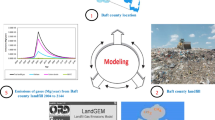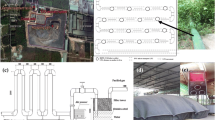Abstract
This study examined the emission of greenhouse gases from municipal solid waste disposal centers in different regions of Iran based on different scenarios. Assuming landfill site opening in 2012 and considering the 20-year plan period for its usage, the amount of wastes entering the landfill site was calculated for 2012–2032. For calculating the production of methane (CH4) and other gases during different years of the project, Land-GEM and IPCC model were used. We defined 9 scenarios for these two models based on the growth rate of population and waste generation. The results revealed that the lowest amount of gas emission in nine scenarios by Land- GEM model was related to non-methane organic compounds (NMOCs). According to the results obtained, the total emissions of greenhouse gases from sanitary landfills for Iran in 2032 were 3,844,000 Mg/year, the largest and lowest amounts of gas emission were related to Tehran region, 860,400 Mg/year, and the South Coast area of the country,138,200 Mg/year, respectively. The major section of the gas production in both landfills was related to greenhouse gas and carbon dioxide emissions. The difference in gas production in the studied regions was due to differences in the percentage of moisture and organic compounds.





Similar content being viewed by others
References
Pazoki M, Delarestaghi RM, Rezvanian MR, Ghasemzade R, Dalaei P. Gas production potential in the landfill of Tehran by landfill methane outreach program. Jundishapur J Health Sci. 2015;7(4):20–5.
Tian H, Gao J, Hao J, Lu L, Zhu C, Qiu P. Atmospheric pollution problems and control proposals associated with solid waste management in China: a review. J Hazard Mater. 2013;252:142–54.
Aydi A. Energy recovery from a municipal solid waste (MSW) landfill gas: A tunisian case study. Hydrol Current Res. 2012;3(4):1–3.
Nolasco D, Lima RN, Hernández PA, Pérez NM. Non-controlled biogenic emissions to the atmosphere from Lazareto landfill, Tenerife, Canary Islands. Environ Sci Pollut Res. 2008;15(1):51–60.
Thompson S, Tanapat S. Modeling waste management options for greenhouse gas reduction. J Environ Inform. 2005;6(1):16–24.
Chalvatzaki E, Lazaridis M. Estimation of greenhouse gas emissions from landfills: application to the Akrotiri landfill site (Chania, Greece). Glob NEST J. 2010;12(1):108–16.
Sadeghi S, Shahmoradi B, Maleki A. Estimating methane gas generation rate from Sanandaj City Landfill using LANDGEM software. Res J Environ Sci. 2015;9(6):280.
Bove R, Lunghi P. Electric power generation from landfill gas using traditional and innovative technologies. Energy Conv Manag. 2006;47(11–12):1391–401.
Eastern Research Group. Background Information Document for Updating AP42 Section 2.4 for Estimating Emissions from Municipal Solid Waste Landfills. U.S. Environmental Protection Agency, Washington, D.C., EPA/600/R-08/116, 2008.
Wang X, Nagpure AS, DeCarolis JF, Barlaz MA. Using observed data to improve estimated methane collection from select US landfills. Environ Sci Technol. 2013;47(7):3251–7.
Talaiekhozani A, Bahrami S, Hashemi SMJ, Jorfi S. Evaluation and analysis of gaseous emission in landfill area and estimation of its pollutants dispersion,(case of Rodan in Hormozgan, Iran). Environ Health Eng Manag J. 2016;3(3):143–50.
Amirmahani N, Yazdanpanah G, Tayebiyan A, Nasiri A, Malakootian M. Estimating methane gas generation rate from Kerman City landfill using LandGEM software. Int J Environ Waste Manag. 2020;26. https://doi.org/10.1504/IJEWM.2020.10029145
Fallahizadeh S, Rahmatinia M, Mohammadi Z, Vaezzadeh M, Tajamiri A, Soleimani H. Estimation of methane gas by LandGEM model from Yasuj municipal solid waste landfill. Iran MethodsX. 2019;6:391–8. https://doi.org/10.1016/j.mex.2019.02.013.
Jigar E, Bairu A, Gesessew A. Application of IPCC model for estimation of methane from municipal solid waste landfill. J Environ Sci Water Resour. 2014;3:52–8.
Ahvaz Jundishapur University of Medical Sciences. Master plan for Iranian municipal solid wastes reuse and recovery and their economical justification, Client: Center for Urban and rural studies, Iranian minstry of Interior (in persian). 2009.
Kamalan H, Sabour M, Shariatmadari N. A review on available landfill gas models. J Environ Sci Technol. 2011;4(2):79–92.
Alexander A, Burklin C, Singleton A. Landfill Gas Emissions Model (LandGEM) Version 3.02. US Environmental Protection Agency, Eastern Research Group; 2005.
Bo-Feng C, Jian-Guo L, Qing-Xian G, Xiao-Qin N, Dong C, Lan-Cui L, et al. Estimation of methane emissions from municipal solid waste landfills in China based on point emission sources. Adv Clim Chang Res. 2014;5(2):81–91.
Eggleston H, Buendia L, Miwa K, Ngara T, Tanabe K. IPCC guidelines for national greenhouse gas inventories. A report prepared by the Task Force on National Greenhouse Gas Inventories of the Intergovernmental Panel on Climate Change. Institute for Global Environmental Strategies: Hayama, Japan. Available at: Accessed 2 April 2008. 2006.
Eggleston, Simon, Leandro Buendia, Kyoko Miwa, Todd Ngara, and Kiyoto Tanabe. "IPCC guidelines for national greenhouse gas inventories." (2006):2006.
Ghasemzade R, Pazoki M. Estimation and modeling of gas emissions in municipal landfill (Case study: Landfill of Jiroft City). Pollution. 2017;3(4):689–700.
Ozcan HK, Guvenc SY, Guvenc L, Demir G. Municipal solid waste characterization according to different income levels: A case study. Sustainability. 2016;8(10):1044.
Kumar S, Smith SR, Fowler G, Velis C, Kumar SJ, Arya S, et al. Challenges and opportunities associated with waste management in India. R Soc Open Sci. 2017;4(3):160764.
Schirmer W, Jucá J, Schuler A, Holanda S, Jesus L. Methane production in anaerobic digestion of organic waste from Recife (Brazil) landfill: evaluation in refuse of diferent ages. Braz J Chem Eng. 2014;31(2):373–84.
Jamshidi A, Taghizadeh F, Ata D. Sustainable municipal solid waste management (case study: Sarab County, Iran). Ann Environ Sci. 2011;5.
Biglari H, Rahdar S, Baneshi MM, Ahamadabadi M, Saeidi M, Narooie MR, et al. Estimating the amount of methane gas generated from the solid waste using the land GEM software, sistan and baluchistan. J Glob Pharma Technol. 2017;9(3):35–41.
Hoklis C, Sharp A. Greenhouse gas emission from municipal solid waste in Phnom Penh, Cambodia. GMSARN Int J. 2014;8:73–8.
Mastellone ML, Brunner PH, Arena U. Scenarios of waste management for a waste emergency area: a substance flow analysis. J Ind Ecol. 2009;13(5):735–57.
Nandan A, Yadav BP, Baksi S, Bose D. Recent scenario of solid waste management in India. World Sci News. 2017(66):56–74.
Aljaradin M, Persson M. K. Environmental impact of municipal solid waste landfills in semi-arid climates-case study–Jordan. Open Waste Manag J. 2012;5(1):28–39.
Sunarto S, Purwanto P, Hadi SP. Quantification of greenhouse gas emissions from municipal solid waste recycling and disposal in Malang city Indonesia. J. Ecol. Eng. 2017;18(3):74–82.
Babel S, Vilaysouk X. Greenhouse gas emissions from municipal solid waste management in Vientiane, Lao PDR. Waste Manag Res. 2016;34(1):30–7.
Liu Y, Ni Z, Kong X, Liu J. Greenhouse gas emissions from municipal solid waste with a high organic fraction under different management scenarios. J Clean Prod. 2017;147:451–7.
Rezaee R, Nasseri S, Mahvi AH, Jafari A, Mazloomi S, Gavami A, et al. Estimation of gas emission released from a municipal solid waste landfill site through a modeling approach: A case study, Sanandaj, Iran. J Adv Environ Health Res. 2014;2(1):13–21.
Kalantarifard A, Yang GS. Estimation of methane production by LANDGEM simulation model from Tanjung Langsat municipal solid waste landfill, Malaysia. Int J Sci Technol. 2012;1(9):481–7.
Singh S, Anunay G, Rohit G, Shivangi G, Vipul V. Greenhouse gas emissions from landfills: a case of NCT of Delhi, India. J Climatol Weather Forecast. 2016;4(1):1–6.
Weitz M, Coburn JB, Salinas E. Estimating national landfill methane emissions: an application of the 2006 Intergovernmental Panel on Climate Change waste model in Panama. J Air Waste Manag Assoc. 2008;58(5):636–40.
Acknowledgements
This work was supported by the Institute for Environmental Research, Tehran University of Medical Science (Grant No. 23313-46-02-92).
Author information
Authors and Affiliations
Corresponding author
Ethics declarations
Conflict of interest
The authors declare that they have no conflict of interest regarding the publication of the current article.
Additional information
Publisher’s note
Springer Nature remains neutral with regard to jurisdictional claims in published maps and institutional affiliations.
Rights and permissions
About this article
Cite this article
Moghadam, M.A., Feizi, R., Panahi Fard, M. et al. Estimating greenhouse emissions from sanitary landfills using Land-GEM and IPCC model based on realistic scenarios of different urban areas: a case study of Iran. J Environ Health Sci Engineer 19, 819–830 (2021). https://doi.org/10.1007/s40201-021-00649-2
Received:
Accepted:
Published:
Issue Date:
DOI: https://doi.org/10.1007/s40201-021-00649-2




